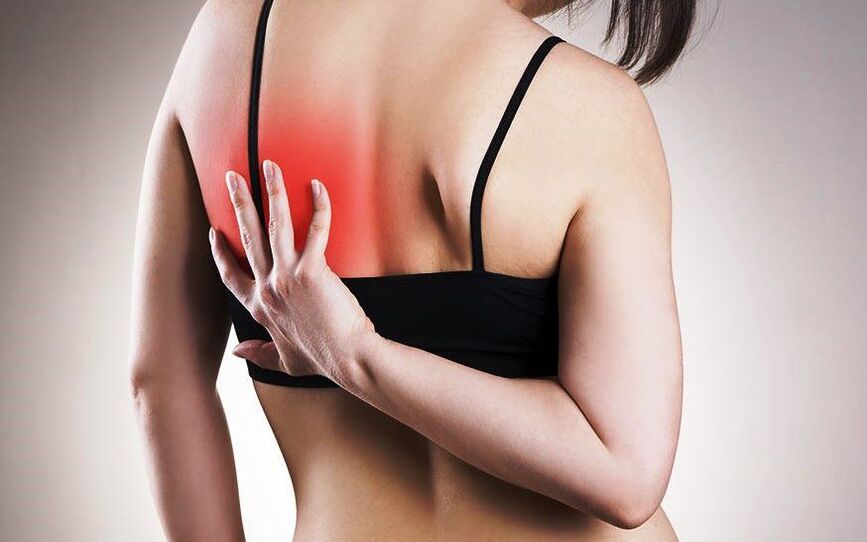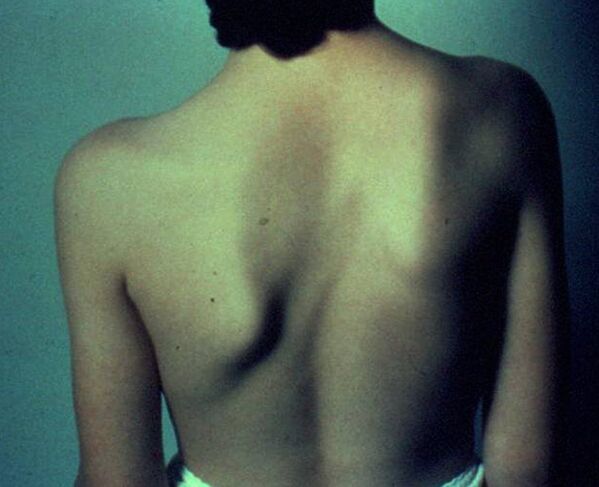
Very often the pain under the left shoulder blade behind the back can be embarrassing. It appears after a sharp and strong movement or a long stay in an unsuccessful position. But it can also be a symptom of a serious illness that requires treatment. The causes of pain can be divided into two main groups: pain caused by diseases of the musculoskeletal system and pain associated with disorders of the internal organs.
Diseases of the musculoskeletal system
Various diseases of the spine can cause pain in the shoulder blade. In addition, pain may be a secondary symptom of injury. The reasons for the pain under the left shoulder blade in the back can be different.
Osteochondritis of the spine
Osteochondrosis occurs due to changes in the spine, when bone tissue is destroyed under the influence of various factors. And there are many factors leading to this pathology:
- Spinal curvature as a result of poor posture. It is often found in students, pupils and office workers.
- Statistical and dynamic overload of the body in immoderate volumes.
- Overweight and malnutrition.
- Back injury.
- Weak immunity and hereditary factor.
- Flat steps.
- Colds and frequent hypothermia, chronic intoxication.
- Metabolic disease.
- Prolonged exposure to vibration.
- Stress and sedentary lifestyle.
In cervicothoracic osteochondrosis there is severe pain in the neck, back, shoulders and upper limbs, it can pull under the shoulder blade. There are pain sensations in the teeth, muscles, abdomen, heart area. The sensation begins to be disturbed by pricking under the shoulder blade, tingling in the neck and chest area, as well as in the neck and abdomen. Sleep is disturbed, the sensitivity of the hands, blood pressure indicators begin to fluctuate and performance decreases. It can also be baked behind the sternum.
Intercostal neuralgia
This disease occurs when the intercostal nerves are irritated, inflamed, pinched or compressed. This occurs with inflammation, infections, chemical poisoning, allergies and hypothermia. The main symptom of neuralgia is pain concentrated in the heart area. It can be dull or sharp, piercing, painful or burning. It can be episodic or permanent.
There may also be increased sweating, discoloration of the skin, tingling or loss of sensation in certain areas. In the forcibly fixed position, the pain syndrome may subside.
Traumatic lesion of the scapula
If the left shoulder blade hurts, the causes may be caused by injuries. They can occur from a direct blow to the shoulder blades or after a fall on the back or shoulder. In the first hours after the injury, a very strong pain syndrome appears. This is a symptom of a fracture of the shoulder blade or ribs. Swelling and edema develop in the future. With a fractured rib, it is difficult for a person to breathe, and bone damage is seen on palpation.
Sprengel's disease

This disease is an abnormally congenital location of the scapula. The cause of this pathology is still unknown to science. It is believed that the disease develops under the influence of external and internal negative factors on the fetus, at 3-4 weeks of pregnancy. At this time, the shoulder girdle and spine are formed. Often this disease is combined with other pathologies: fusion of the ribs, strabismus, the formation of additional hemivertebrae and abnormal structure of the cervical region.
The pathology is detected immediately after the birth of the child. At a mild stage of the disease are prescribed: exercise therapy, massage, water treatments, physiotherapy. In moderate and severe cases, surgical treatment is prescribed.
Myofascial syndrome
Under the influence of various factors, the work of the muscular apparatus and the membranes covering the muscles is disturbed. There are small painful seals in the muscles, the so-called trigger points. They appear under the influence of trauma and muscle tension. There are several factors leading to their formation: forced posture, diseases of the spine, bruises, monotonous movements, somatic diseases, emotional stress.
The main symptom is pain, which has a painful, pulling nature, which increases with effort and activation of triggers. Skin sensitivity also increases, skin color changes, movement in the affected area is limited. Complex treatment is prescribed. For prevention you should monitor your weight, adhere to a healthy lifestyle, wear comfortable shoes and clothes, avoid stress and hypothermia.
Changes in the work of internal organs
If there is pain in the left shoulder blade, the reasons may be a violation of internal organs. In many diseases, the symptom is pain in the left side. They are divided into cardiac, diseases of the bronchopulmonary system and gastrointestinal tract.
Heart disease
In heart disease hurts not only in the left shoulder blade, but also in the clavicle, left arm, abdomen. Myocardial infarction is one of the types of coronary heart disease in which necrosis of the heart muscle occurs as a result of impaired coronary circulation. There is burning, squeezing or squeezing pain behind the sternum, radiating to the left clavicle, shoulder blade, arm and jaw. The patient appears cold sweat, there is a feeling of fear. These symptoms are a direct indication of emergency hospitalization. If timely medical care is not provided, then a fatal outcome is possible.
The cause of coronary heart disease is insufficient blood supply to the heart muscle due to coronary heart disease. The coronary arteries become clogged with cholesterol plaques or narrow. The heart does not receive enough blood to function normally. The reasons are:
- Atherosclerosis of the coronary vessels.
- hypertension.
- Disorders of lipid and lipoprotein metabolism.
- Smoking.
- High cholesterol and overweight.
- Diabetes.
Symptoms include shortness of breath, weakness, arrhythmia, sweating. There is spontaneous chest pain that does not respond to nitroglycerin. The patient experiences a lack of oxygen, fear of death, apathy, gloomy mood or unwarranted anxiety. In an attack of angina pectoris, the pain is concentrated behind the sternum. It has a cutting, pressing, pressing and burning character of manifestation. The attack lasts from 2 to 5 minutes and is effectively stopped with medication.
In pericarditis, an inflammatory process occurs in the outer lining of the heart. The causes of inflammation are infections, autoimmune diseases, injuries, tumors, metabolic disorders. There is pressing pain in the chest, swelling of the face and neck, shortness of breath, dry cough and hoarse voice.
Mitral valve prolapse is a pathology in which the function of the valve located between the ventricle and the atrium is impaired. It is detected by accident and does not pose a threat to the patient's life. It can be congenital or acquired. Another disease that is usually asymptomatic is an aortic aneurysm. In this pathology there is a protrusion of the vascular wall due to its weakening or a sharp rise in blood pressure. The vessel wall is weakened by the deposition of foreign substances, inflammation or destruction of tissues.
Pathologies of the bronchopulmonary system
In diseases of the bronchopulmonary system, pain occurs in the left shoulder blade.
The reasons for the symptom of pain: acute bronchitis and tracheobronchitis, left-sided pneumonia, dry left-sided pleurisy, abscess of the left lung. Acute bronchitis is manifested by cough, weakness, increased sweating, shortness of breath and decreased activity, fever up to 38 degrees. The reasons for the development of the pathology are of viral or bacterial origin. Physical, chemical and allergic factors also affect.
Left-sided pneumonia is rare but life-threatening. The main reason is the penetration of pathogens into the left lung. This occurs with a strong decrease in immunity. There is a strong debilitating cough, burning and pain on the left side of the chest, body temperature rises. It is necessary to seek help as soon as possible, this will help avoid the development of complications. A disease such as dry pleurisy can be a complication of other lung pathologies. Lung abscess is a complication. It is formed as a result of insufficiently treated pneumonia.
Diseases of the gastrointestinal tract
A very common group of diseases in which the pain radiates from the back to the left shoulder blade. The reasons may be different. The increase in pathologies is associated with errors in nutrition, the use of foods containing flavors and preservatives. The symptoms of these diseases are:
- Stomach ache.
- Heartburn.
- Burping.
- Flatulence.
- Nausea and vomiting.
- constipation.
- diarrhea.
- Bad breath.
- Reduced body weight and appetite.
- Dizziness.
- Weakness.
Gastric ulcer disrupts the integrity of the tissues of the stomach wall, as a result of which they are eaten away by gastric juice and ulcers appear. A characteristic feature are hunger pains, which appear against the background of hunger. After eating, they disappear. Another symptom is vomiting with acidic content. Stomach motility is also impaired, resulting in belching and heartburn. A complication of the disease may be bleeding due to the defeat of the ulcer of blood vessels. This is a very serious disease in which self-medication is dangerous as it can lead to ulcer perforation and death.
The main symptom of duodenal ulcer is pain in the epigastric region, which can radiate to the left side of the chest and shoulder blade, lumbar or thoracic spine.
The pain appears after eating, and also after some time. It is stopped with antacids, antispasmodics and antisecretory agents. Also, ulcers are characterized by dyspeptic disorders, loss of appetite, leading to weight loss and painful weight loss. The ulcer causes complications: bleeding, perforation and penetration of the pancreas, duodenal stenosis, tumor formation at the site of ulcer formation and inflammation of the intestinal mucosa.
Esophageal spasm is characterized by impaired swallowing.
The reason may be agitation, as well as rapid absorption and poor chewing of food, consumption of foods high in fiber. You can alleviate the discomfort by drinking plenty of fluids, inhaling air, and exercising. Also a symptom is the reverse reflux of the contents of the esophagus. It often occurs during sleep or when the patient is in a horizontal position. It manifests itself in the form of vomiting without the admixture of gastric juice and bile.
Gastroesophageal reflux disease develops when the contents of the stomach and duodenum reflux.
The main reason is the weakness of the lower esophageal sphincter. In this case, when the stomach shrinks, its contents are expelled back into the esophagus. It is characterized by heartburn, which occurs when bending over, exercising, after a hearty meal. There is belching with a bitter or sour taste. You may also experience nausea and vomiting.
Signs of acute pancreatitis are severe, persistent, sharp pain under the ribs.
There are two reasons: alcohol abuse and cholelithiasis. The symptoms are not always clear. The pain is poorly relieved by painkillers, sometimes it is necessary to prescribe drugs. Also, pain under the shoulder blade can bother intestinal colitis. Occurs due to infections, drugs, chemical or food poisoning, circulatory disorders.












































